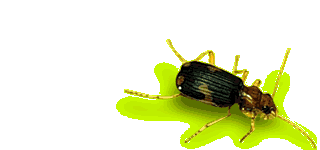
ITHACA, N.Y. -- This fall, the U.S. Post Office will issue a stamp with the image of an iridescent, bright-blue bombardier beetle.
What's so special about this insect? Well, aside from the fact that the bombardier beetle's origins predate humanity to a time when all the continents on Earth were joined, it is the only life form other than humankind that creates explosions.
"To protect itself against predators, especially ants, the bombardier beetle emits an explosive spray of chemicals with an audible 'pop,' the sound of a small firecracker," explains Dr. Thomas Eisner, a neurobiologist from Cornell University in Ithaca.
"The heat generated by the explosion is that of boiling water. The scalding spray is very effective in deterring predators. Early explorers, describing the African variety of the beetle, stated that when they 'play off their artillery' they are so hot to the touch 'that only few can be captured with the naked hand.'"
The Bombardier beetle is also unique because it is a marksman. It can aim its spray anywhere that it is being attacked along its body. It can even "shoot" its blistering spray over its own back, bouncing the searing fluid off of a pair of reflectors that it deploys specifically for that purpose.
Eisner was so fascinated by the bombardier that he took a series of one-of-a-kind flash photos of the beetle. The photos, the first evidence of the remarkable degree of precision with which the beetle targets its enemies, have just been published in the prestigious journal Proceedings of the National Academy of Sciences.
A single beetle can detonate its spray more than 20 times before exhausting its ammunition. The explosive spray is created within the beetle's body by a pair of defensive glands. The larger of those glands is a chamber containing irritating substances known as hydroquinones mixed with hydrogen peroxide. The smaller gland, a sort of reaction chamber, contains special enzymes known as catalases and peroxidases. To set off the explosion, the beetle mixes the contents of the two compartments.
"Hydrogen peroxide is the fuel the Germans used to power their V-1 rockets in World War II, so the explosion has quite a punch relative to the beetle's one-inch size," says Dr. Eisner.
Surprisingly, the name "bombardier" does not have any aerial connotations. While the smaller American version of the beetle can fly at treetop level, the larger African version cannot fly. It was named in the 19th Century, a time when mounted calvarymen would throw the equivalent of what today would be called hand grenades. At that time those explosives were called bombs, and the horsemen were called bombardiers. Since the beetle also set off explosives, it was dubbed the bombardier beetle.
Dr. Breecher is the co-author of two books,Healthy Homes in a Toxic World and Live Longer Better.
